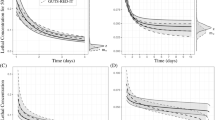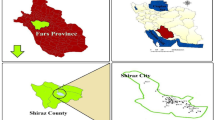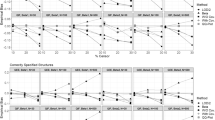Abstract
The NORMTOX model predicts the lifetime-averaged exposure to contaminants through multiple environmental media, that is, food, air, soil, drinking and surface water. The model was developed to test the coherence of Dutch environmental quality objectives (EQOs). A set of EQOs is called coherent if simultaneous exposure to different environmental media that are all polluted up to their respective EQOs does not result in exceeding the acceptable or tolerable daily intake (ADI or TDI). Aim of the present study is to separate the impact of uncertainty and interindividual variability in coherence predictions with the NORMTOX model. The method is illustrated in a case study for chlorfenvinphos, mercury and nitrate. First, ANOVA was used to calculate interindividual variability in input parameters. Second, nested Monte Carlo simulation was used to propagate uncertainty and interindividual variability separately. Lifetime-averaged exposure to chlorfenvinphos, mercury and nitrate was modeled for the Dutch population. Output distributions specified the population fraction at risk, due to a particular exposure, and the reliability of this risk. From the case study, it was obtained that at lifelong exposure to all media polluted up to their standard, 100% of the Dutch population exceeds the ADI for chlorfenvinphos, 15% for mercury and 0% for nitrate. Variance in exposure to chlorfenvinphos, mercury and nitrate is mostly caused by interindividual variability instead of true uncertainty. It is concluded that the likelihood that ADIs of chlorfenvinphos and mercury will be exceeded should be further explored. If exceeding is likely, decision makers should focus on identification of high-risk subpopulations, rather than on additional research to obtain more accurate estimates for particular parameters.
This is a preview of subscription content, access via your institution
Access options
Subscribe to this journal
Receive 6 print issues and online access
$259.00 per year
only $43.17 per issue
Buy this article
- Purchase on Springer Link
- Instant access to full article PDF
Prices may be subject to local taxes which are calculated during checkout


Similar content being viewed by others
References
Berthouex P.M., and Brown L.C. Statistics for Environmental Engineers. CRC Press LLC, Florida, 1994.
BIBRA. A Critical Review of the Methodology for the Estimation of Dietary Intake of Food Chemicals in the UK. MAFF Report 1A005, UK, 1995.
Bogen K.T., and Spear R.C. Integrating uncertainty and interindividual variability in environmental risk assessment. Risk Anal 1987: 7 (4): 427–436.
Breuninger M.I., Schachtel G.A., Lührmann P.M., Hartmann B., and Neuhäuser-Berthold M. Complex correlation structure in consumption rates of major food groups: implications for the assessment of radiation exposure. Public Health Nutr 2006: 6 (1): 87–94.
Buck R.J., Hammerstrom K.A., and Ryan P.B. Bias in population estimates of long-term exposure from short-term measurements of individual exposure. Risk Anal 1997: 17 (4): 455–466.
Buck R.J., Ozkaynak H., Xue J.P., Zartarian V.G., and Hammerstrom K. Modeled estimates of chlorpyrifos exposure and dose for the Minnesota and Arizona NHEXAS populations. J Expo Sci Environ Epidemiol 2001: 11 (3): 253–268.
Bukowski J., Korn L., and Wartenberg D. Correlated inputs in quantitative risk assessment: The effects of distributional shape. Risk Anal 1995: 15 (2): 215–219.
Burmaster D.E., and Wilson A.M. An introduction to second-order random variables in human health risk assessments. Human Ecol Risk Assess 1996: 2 (4): 892–919.
Chavarri M.J., Herrera A., and Arino A. The decrease in pesticides in fruit and vegetables during commercial processing. Int J Food Sci Technol 2005: 40 (2): 205–211.
Cohen J.T., Lampson M.A., and Bowers T.S. The use of two-stage Monte Carlo simulation techniques to characterize variability and uncertainty in risk analysis. Human Ecol Risk Assess 1996: 2 (4): 939–971.
Cullen A. Comparison of measured and predicted environmental PCB concentrations using simple compartmental models. Environ Sci Technol 2002: 36 (9): 2033–2038.
Cullen A.C., and Frey H.C. Probabilistic Techniques in Exposure Assessment, A Handbook for Dealing with Variability and Uncertainty in Models and Inputs. Society for Risk Analysis, Plenum Press, New York, 1999.
Decisioneering Inc.. Crystal Ball 2000, User Manual. Colarado, USA, 2000.
DEFRA (Department for Environment, Food and Rural Affairs). Contaminated Land Exposure Assessment (CLEA). Available at: www.environment-agency.gov.uk/subjects/landquality/ accessed November 2 2006.
Dejonckheere W., Steurbaut W., Drieghe S., Verstraeten R., and Braeckman H. Pesticide residue concentrations in the Belgian total diet, 1991–1993. J AOAC Int 1996: 79 (2): 520–528.
Ferson S. What Monte Carlo methods cannot do. Human Ecol Risk Assess 1996: 2 (4): 990–1007.
Frey H.C. Quantitative Analysis of Uncertainty and Variability in Environmental Policy Making. AAAS/EPA, Research Associate Center for Energy and Environmental Studies, Pittsburgh, USA, 1992.
Frey H.C., and Burmaster D.E. Methods for characterizing variability and uncertainty: comparison of bootstrap simulation and likelihood-based approaches. Risk Anal 1999: 19 (1): 109–130.
Fryer M., Collins C.D., Ferrier H., Colvile R.N., and Nieuwenhuijsen M.J. Human exposure modeling for chemical risk assessment: a review of current approaches and research and policy implications. Environ Sci Policy 2006: 9: 261–274.
Gaddum J.H. Lognormal distributions. Nature 1945: 156: 463–466.
Haas C.N. On modeling correlated random variables in risk assessment. Risk Anal 1999: 19 (6): 1205–1214.
Hammersley J.S., and Handscomb D.C. Monte Carlo Methods. John Wiley and Sons Inc., New York, 1964.
Hoffman F.O., and Hammonds J.S. Propagation of uncertainty in risk assessments: the need to distinguish between uncertainty due to lack of knowledge and uncertainty due to variability. Risk Anal 1994: 14: 707–712.
Hulshof K.F.A.M., Kistemaker C., and Bouman M. De consumptie van groepen voedingsmiddelen door Nederlandse bevolkingsgroepen, Voedselconsumptiepeiling 1997–1998. TNO-report v98.804, Netherlands Organisation for Applied Scientific Research TNO, Zeist, The Netherlands (in Dutch), 1998.
Kelly E.J., and Campbell K. Separating variability and uncertainty in environmental risk assessment—Making choices. Human Ecol Risk Assess 2000: 6 (1): 1–13.
Kim H., and Weisel C.P. Dermal absorption of dichloro- and trichloroacetic acids from chlorinated water. J Expo Sci Environ Epidemiol 1998: 8 (4): 555–575.
Lessmann K., Beyer A., Klasmeier J., and Matthies M. Influence of distributional shape of substance parameters on exposure model output. Risk Anal 2005: 25 (5): 1137–1145.
MAFF (Ministry of Agriculture, Fisheries and Food). Consumer exposure Model: User Manual. Pesticide Safety Directorate, UK, 1996.
McKone T.E., and Ryan P.B. Human exposures to chemicals through food chains: an uncertainty analysis. Environ Sci Technol 1989: 23: 1154–1163.
Mokhtari A., and Frey H.C. Sensitivity analysis of a two-dimensional probabilistic risk assessment model using analysis of variance. Risk Anal 2005a: 25 (6): 1511–1529.
Mokhtari A., and Frey H.C. Recommended practice regarding selection of sensitivity analysis methods applied to microbial food safety process risk models. Human Ecol Risk Assess 2005b: 11 (3): 591–605.
Mokhtari A., and Frey H.C. Evaluation of sampling-based methods for sensitivity analysis: case study for the E. Coli food safety process risk model. Human Ecol Risk Assess 2006: 12 (6): 1128–1152.
Morgan M.G., and Henrion M. Uncertainty: a Guide to Dealing with Uncertainty in Quantitative Risk and Policy Analysis. Cambridge University Press, UK, 1990.
Nauta M.J. Separation of uncertainty and variability in quantitative microbial risk assessment models. Int J Food Microbiol 2000: 57: 9–18.
NRC (National Research Council). Reactor Safety: an Assessment of Accident Risks in the U.S. Commercial Nuclear Power Plants. Nuclear Regulatory Commission, NUREG-75-014 (WASH-1400), Washington, DC, USA, 1975.
NRC (National Research Council). Science and Judgment in Risk Assessment. National Academy Press, Washington, DC, USA, 1994.
OSACDTSC (Office of Scientific Affairs, California Department of Toxic Substances Control). Caltox, a Multimedia Total Exposure Model for Hazardous-Waste Sites. Part I. Executive Summary. California Environmental Protection Agency, Sacramento, USA, 1993.
Price P.S., Su S., Harrington J., and Keenan R. Uncertainty and variation in indirect exposure assessment: an analysis of exposure to tetrachlorodibenzo-p-dioxin from a beef consumption pathway. Risk Anal 1996: 16: 263–277.
Price P.S., Young J.S., and Chaisson C.F. Assessing aggregate and cumulative pesticide risks using a probabilistic model. Ann Occup Hyg 2001: 45: S131–S142.
PSD (Pesticides Safety Directorate). Operator Exposure Models on the PSD Website, Available: http://www.pesticides.gov.uk/, accessed at 2 November 2006, 2003.
Ragas A.M.J., and Huijbregts M.A.J. Evaluating the coherence between environmental quality objectives and the acceptable or tolerable daily intake. Regul Toxicol Pharmacol 1998: 27: 251–264.
RATSC (Risk Assessment and Toxicology Steering Committee). Risk Assessment Approaches Used by UK Government for Evaluating Human Health Effects of Chemicals. Institute for Environment and Health, University of Leicester, UK, 1999.
Roseberry A.M., and Burmaster D.E. Lognormal distributions for water intake by children and adults. Risk Anal 1992: 12 (1): 99–104.
Ruffle B., Burmaster D.E., Anderson P.D., and Gordon H.D. Lognormal distributions for fish consumption by the general U.S. population. Risk Anal 1994: 14 (4): 395–404.
Saltelli A., Tarantola S., Campolongo F., and Ratto M. Sensitivity Analysis in Practice. A Guide to Assessing Scientific Models. John Wiley & Sons publishers, Chichester, UK, 2004.
Slob W. Modeling long-term exposure of the whole population to chemicals in food. Risk Anal 1993: 13: 525–530.
Slob W. Probabilistic dietary exposure assessment taking into account variability in both amount and frequency of consumption. Food Chem Toxicol 2006: 44: 933–951.
Slob W., and Bakker M.I. Probabilistische berekening van inname van stoffen via incidenteel geconsumeerde voedingsproducten. Report 320103003/2004. National Institute of Public Health and the Environment, Bilthoven, The Netherlands (in Dutch), 2004.
Smith A.E., Ryan P.B., and Evans J.S. The effect of neglecting correlations when propagating uncertainty and estimating the population distribution of risk. Risk Anal 1992: 12: 467–474.
Stanek E.J., Calabrese E.J., and Xu L. A caution for Monte Carlo risk assessment of long term exposures based on short term exposure study data. Human Ecol Risk Assess 1998: 4 (2): 409–422.
U.S. EPA. Exposure Factors Handbook, Volume III, Activity Factors. EPA/600/p-95/002fc. U.S. EPA, Office of Research and Development, Washington, DC, 1997.
Van Veen M.P. CONSEXPO: a program to estimate Consumer Product Exposure and Uptake. Report 612810 002, National Institute of Public Health and the Environment, Bilthoven, The Netherlands, 1995.
Von Stackelberg K.E., Burmistrov D., Vorhees D.J., Bridges T.S., and Linkov I. Importance of uncertainty and variability to predicted risks from trophic transfer of PCBs in dredged sediments. Risk Anal 2002: 22 (3): 499–512.
Wallace L., and Williams R. Validation of a method for estimating long-term exposures based on short-term measurements. Risk Anal 2005: 25 (3): 687–694.
WHO (World Health Organization). Human Exposure Assessment. Environmental Health Criteria 214. International Program on Chemical Safety (IPCS), Geneva, Switzerland, 2000.
Wilson N.D., Shear N.M., Paustenbach D.J., and Price P.S. The effect of cooking practices on the concentration of DDT and PCB compounds in the edible tissue of fish. J Expo Sci Environ Epidemiol 1998: 8 (3): 423–440.
Wu F.C., and Tsang Y.P. Second-order Monte Carlo uncertainty/variability analysis using correlated model parameters: application to salmonid embryo survival risk assessment. Ecol Modell 2004: 177: 393–414.
Yokota F., Gray G., Hammitt J.K., and Thompson K.M. Tiered chemical testing: a value of information approach. Risk Anal 2004: 24 (6): 1625–1639.
Zar J.H. Biostatistical Analysis. 4th edn. Prentice-Hall, Upper Saddle River, NJ, 1999.
Zatarian V.G., Ozkaynak H., Burke J.M., Zufall M.J., Rigas M.L., and Furtaw Jr E.J. A modeling framework for estimating children's residential exposure and dose to chlorpyrifos via dermal residue contact and nondietary ingestion. Environ Health Perspect 2000: 108 (6): 505–514.
Zheng J., and Frey H.C. Quantitative analysis of variability and uncertainty with known measurement error: methodology and case study. Risk Anal 2005: 25 (3): 663–675.
Acknowledgements
This research was financially supported by the European Union (European Commission, FP6 project NoMiracle, Contract No. 003956). We thank the two anonymous reviewers for their valuable suggestions, which significantly improved the paper.
Author information
Authors and Affiliations
Corresponding author
Additional information
Supplementary information accompanies the paper on the Journal of Exposure Analysis and Environmental Epidemiology website (http://www.nature.com/jes)
Supplementary information
Rights and permissions
About this article
Cite this article
Ragas, A., Brouwer, F., Büchner, F. et al. Separation of uncertainty and interindividual variability in human exposure modeling. J Expo Sci Environ Epidemiol 19, 201–212 (2009). https://doi.org/10.1038/jes.2008.13
Received:
Accepted:
Published:
Issue Date:
DOI: https://doi.org/10.1038/jes.2008.13
Keywords
This article is cited by
-
Assessment of the Long-Term Exposure to Lead in Four European Countries Using PBPK Modeling
Exposure and Health (2024)
-
Polymetallic pollution from abandoned mines in Mediterranean regions: a multidisciplinary approach to environmental risks
Regional Environmental Change (2018)



